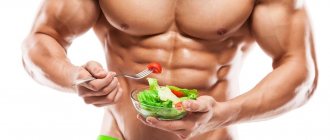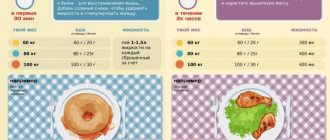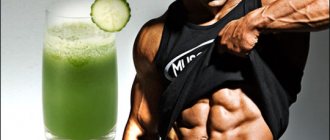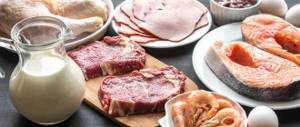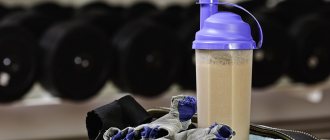To grow muscle mass, you need a proper diet with an emphasis on protein. Even the most ideal training program will be useless if the menu is not balanced. The body needs proteins, fats and carbohydrates to restore energy after exercise and build muscle. Nutrition for muscle growth means following the correct diet with calorie counting and nutritional supplements. Proteins, fats and carbohydrates supplied with food must necessarily exceed the calorie content of energy consumption per day.
Protein sources should provide up to 30-35% of total calories, carbohydrates - up to 50-60%, and fats - 10-20%.
Energy from the breakdown of fats is needed to increase endurance during training. Healthy fats are found in dairy and fermented milk products, nuts and oils. Fats in the diet should consist of 70% animal origin and 35% plant origin.
To gain weight, meals are divided into 5-6 meals per day. For convenience, create a diet for the week, detailing it for each day. Divide the food for each meal into containers and take it to work. Proper planning will prevent the temptation to indulge in extra calories.
Eating before training is done an hour before it. To get energy before strength training, choose carbohydrates: proteins take much longer to digest.
After training, you should also snack on carbohydrates, and have a full meal no later than two hours from the end of the exercise. Carbohydrates help replenish glycogen stores and return expended energy. Proteins provide the body with the amino acids necessary for the synthesis of muscle fibers.
Avoid fasting while gaining weight. The muscles are left without the necessary nutrition, and the body begins to process them to maintain life. It’s not as scary to overeat while gaining weight as it is to undereat.
A lack of calories and micronutrients can lead to the breakdown of muscle fibers. Excess fat can always be burned with additional exercise.
Allowed foods for gaining muscle mass:
- lean meat: beef, chicken, turkey;
- seafood and fish;
- dairy and fermented milk products;
- cheese;
- eggs;
- nuts;
- cereals;
- pasta;
- Rye bread;
- vegetables (limited beets, potatoes and carrots);
- mushrooms;
- fruits (bananas, persimmons, pineapples, watermelon are best eaten after training);
- dried fruits.
- Carrot cake
The right approach to gaining muscle mass
To grow, you must consume more calories each day than you need to maintain a stable body weight. If you eat 3,000 calories a day and don't gain weight, then 3,000 calories is your equilibrium level. By getting this amount of calories every day, you maintain a constant weight.
To GAIN weight (muscle!), you simply have to eat more than you need to maintain a stable body weight. It really is as simple as it sounds.
I anticipate your next question...how do I know my level of balance? The answer is still unknown to you. Not yet. But we will soon find out. To understand how the body responds to a certain caloric intake, you will have to go by trial and error. Here's what you need to do:
- Start with 3500 calories per day.
Get 3,500 calories daily for two weeks. At this time, you are required to count and record your caloric intake. Eat no more and no less. - Not gaining weight?
If you DO NOT gain weight while eating 3,500 calories for two weeks, increase your energy intake to 3,800 calories for the next two weeks. If you still don't gain weight, increase your caloric intake again. - Have you collected too much?
If you have gained more than 1.5-2 kg in two weeks, reduce the calorie intake to 3200 and evaluate the result after two weeks. If you are still gaining weight too quickly, continue to reduce your daily energy intake.
Basics
First, your refrigerator...
You need to fill it with a whole range of different healthy products (preferably for a week in advance), with which you will prepare meals for rapid muscle growth. And also prevent snacking on useless foods, which should be limited, because not everyone needs the nutrition of an ectomorph, which must increase the caloric content of the diet by any means. Here is a sample list of what foods to eat:
- Carbohydrates: Buckwheat, rice, sweet potatoes, white potatoes, brown rice, durum wheat pasta.
- Protein: Chicken breast, beef, cottage cheese, protein powder, eggs, egg white, fish, Greek yogurt.
- Fruits and vegetables: Berries, bananas, tropical fruits, various greens, legumes, avocados.
- Fats: Use a spray, teaspoons instead of tablespoons - coconut and olive oil.
- Snacks: Seeds and nuts.
5 important tips
- Eat regularly
Don't let your body go into starvation mode. When you're hungry, you're likely to snack on empty foods. By eating consistently, you maintain your blood sugar levels and metabolism.
- Limit your consumption of processed foods
Processed foods tend to be high in calories and low in nutrients, so try to avoid them.
- Drink enough water
Hydration is important. If you consume enough fluid, your performance and study will improve, and the feeling of hunger may even dull.
- What to do with carbohydrates?
Carbohydrates are not your enemy, but it is better to plan their consumption. For example, simple carbohydrates are great to take before or after a workout because of the rapid release of energy as well as the restoration of glycogen stores. Complex carbohydrates can be consumed at any time because they do not cause spikes in blood sugar.
- Protein
Not only does protein help your muscles grow and repair, but it's also great for keeping you full and speeding up your metabolism. The best sources of protein are low-fat beef, chicken, turkey, fish and skim milk. Protein shakes are perfect for quickly replenishing protein reserves.
Despite all the existing myths, the training diet for gaining muscle is quite simple. And it doesn’t require you to eat chicken breast, broccoli and brown rice with buckwheat every day.
But - there are factors that you need to consider in nutrition: these are your daily calorie intake, the amount of protein, carbohydrates and fats consumed. Let's dive deeper into the theory before we get acquainted with the principles of creating a diet according to BZHU and an approximate nutrition plan for building muscle.
At what rate should I gain weight?
An aspiring natural bodybuilder who trains hard and eats right should gain between 10 and 10 pounds of muscle mass in the first year of hardcore training. Athletes with an average level of training and experienced bodybuilders will not gain weight as quickly. According to Casey Butt, a natural bodybuilder can expect the following rates of muscle gain:
- 1 year
– 7-8 kg of muscle mass - 2 year
– 4 kg muscle mass - 3 year
– 2 kg muscle mass - 4 year
– 1 kg of muscle mass - 5 year
– 0.5 kg of muscle mass
As you increase muscle mass, you will inevitably accumulate some fat. A little. Remember, your muscle gain strategy doesn't have to turn you into a sumo wrestler, but you are allowed to gain between 2.5 and 5 kg of body fat per year. Some will gain more fat, some will gain less. If you fear fat and undereat, you will severely limit your potential for gaining muscle mass. Bodybuilding requires creation, and for this you have to eat more. You won't make the most progress if you cut back on your diet. It will be a long time before you see those six-pack abs again, but by then you will have become a real muscle monster!
Below is an approximate plan for gaining muscle mass based on your level of physical fitness and existing experience with muscle growth:
- Beginners.
Beginning bodybuilders who have not previously worked on gaining muscle mass should set the bar at gaining 1 kg of total mass per month for the first year. Ideally, this will allow you to gain 8 kg of muscle and 4 kg of fat mass. - Repeaters.
Repeaters (or those who have already gained about 8 kg of muscle mass) should move the bar by 0.5 kg per month, and so on over the next year. Ideally, this would correspond to 4 kg of muscle and 2 kg of fat tissue. - Middle peasants.
In the third year, weightlifters (as well as those who have already gained 12 kg of muscle mass) should set a goal of gaining 1 kg every 3 months. Ideally, this schedule will help you gain 2 kg of muscle and 2 kg of fat mass. - Experienced.
Weightlifters who have passed the 3-year mark (as well as those who have gained about 14 kg of muscle mass) should set themselves the goal of gaining 0.5 kg per two months during the fourth year of training. Under ideal circumstances, this will lead to a gain of 1 kg of muscle and 2 kg of fat. - Advanced.
If you are in your fifth year of training (or longer) or have already gained about 15 kg of muscle mass, you should set a goal of gaining 0.5 kg of total mass every 2 months, and so on for a year. At best, this will allow you to gain 0.5-1 kg of muscle and 2 kg of fat mass.
How to Eat on 2000, 3000 and 4000 Calories a Day
How many calories you need per day depends on your gender, age, weight and activity level. The higher your activity level, the more calories you need to consume. This is especially true for those who want to gain muscle mass. Whatever your goals, we can help you achieve them by redefining your diet. You will learn how to eat 2000 calories, 3000 and 4000 calories, and what foods to eat.
Contents of the material
Note for "skinny" guys
If you are underweight, you should increase your daily diet until you reach normal height and weight levels. For skinny guys, you can set the goal of gaining 1.5 to 3 kg every month until the weight reaches the lower limit of normal. The table will help you determine normal weight based on your body type.
| Height | Ectomorph | Mesomorph | Endomorph |
| 158 | 51,1 — 54,7 | 53,8 — 58,9 | 57,4 — 64,2 |
| 159 | 51,6 — 55,2 | 54,3 — 59,6 | 58,0 — 64,8 |
| 160 | 52,2 — 55,8 | 54,9 — 60,3 | 58,5 — 65,3 |
| 161 | 52,7 — 56,3 | 55,4 — 60,9 | 59,0 — 66,0 |
| 162 | 53,2 — 56,9 | 55,9 — 61,4 | 59,6 — 66,7 |
| 163 | 53,8 — 57,4 | 56,5 — 61,9 | 60,1 — 67,5 |
| 164 | 54,3 — 57,9 | 57,0 — 62,5 | 60,7 — 68,2 |
| 165 | 54,9 — 58,5 | 57,6 — 63,0 | 61,2 — 68,9 |
| 166 | 55,4 — 59,2 | 58,1 — 63,7 | 61,7 — 69,6 |
| 167 | 55,9 — 59,9 | 58,6 — 64,4 | 62,3 — 70,3 |
| 168 | 56,5 — 60,6 | 59,2 — 65,1 | 62,9 — 71,1 |
| 169 | 57,2 — 61,3 | 59,9 — 65,8 | 63,6 — 72,0 |
| 170 | 57,9 — 62,0 | 60,7 — 66,6 | 64,3 — 72,9 |
| 171 | 58,6 — 62,7 | 61,4 — 67,4 | 65,1 — 73,8 |
| 172 | 59,4 — 63,4 | 62,1 — 68,3 | 66,0 — 74,7 |
| 173 | 60,1 — 64,2 | 62,8 — 69,1 | 66,9 — 75,5 |
| 174 | 60,8 — 64,9 | 63,5 — 69,9 | 67,6 — 76,2 |
| 175 | 61,5 — 65,6 | 64,2 — 70,6 | 68,3 — 76,9 |
| 176 | 62,2 — 66,4 | 64,9 — 71,3 | 69,0 — 77,6 |
| 177 | 62,9 — 67,3 | 65,7 — 72,0 | 69,7 — 78,4 |
| 178 | 63,6 — 68,2 | 66,4 — 72,8 | 70,4 — 79,1 |
| 179 | 64,4 — 68,9 | 67,1 — 73,6 | 71,2 — 80,0 |
| 180 | 65,1 — 69,6 | 67,8 — 74,5 | 71,9 — 80,9 |
| 181 | 65,8 — 70,3 | 68,5 — 75,4 | 72,7 — 81,8 |
| 182 | 66,5 — 71,0 | 69,2 — 76,3 | 73,6 — 82,7 |
| 183 | 67,2 — 71,8 | 69,9 — 77,2 | 74,5 — 83,6 |
| 184 | 67,9 — 72,5 | 70,7 — 78,1 | 75,2 — 84,5 |
| 185 | 68,6 — 73,2 | 71,4 — 79,0 | 75,9 — 85,4 |
| 186 | 69,4 — 74,0 | 72,1 — 79,9 | 76,7 — 86,2 |
| 187 | 70,1 — 74,9 | 72,8 — 80,8 | 77,6 — 87,1 |
| 188 | 70,8 — 75,8 | 73,5 — 81,7 | 78,5 — 88,0 |
Example of a diet for gaining muscle mass
The following diet is provided as a sample. Modify it to suit your individual needs.
- 6:00 – Get up!
Immediately after waking up, drink a whey protein shake. Whey protein is absorbed quickly, and this will allow us to instantly fill a hungry body with amino acids and nutrients. - 6:30 – breakfast:
4 egg omelet with cheese, tomatoes and onions; oatmeal with fresh fruit; a large glass of whole milk. - 9:15
– drink a cocktail of gainer or whey protein mixed with banana, whole milk and peanut butter. - Noon
– hearty lunch of your choice. Be sure to include vegetables! Possible options: cheeseburger with a large portion of potatoes (with sauce) and broccoli, chicken tacos with rice and refried beans. Wash your lunch with juice or milk. - 14:30 – Pre-workout:
protein shake with casein and fresh fruit. - 15:30 – Training!
Drink more water during your workout. - 16:30 – Post-workout:
Immediately after finishing your workout, drink a protein shake that will contain 30-50 g of whey protein in combination with dextrose/waxy maize - quickly absorbed carbohydrates that provoke an insulin “spike” and are replenished in the muscles glycogen reserves used up during exercise. - 17:30 – Big lunch!
The largest meal of the day. Be sure to include vegetables and healthy carbohydrates. - 20:30 – To the side!
It's time to go to bed. Just before going to bed, drink a casein shake - a source of slow protein that will feed the body during sleep.
Keep in mind that to effectively gain muscle mass, you should:
- Eat high-protein foods.
Try to eat at least 30-40 g of protein every 2.5-3 hours. Increasing your daily protein intake in combination with strength training will help you gain lean muscle mass. - Don't forget about vegetables and fruits.
Be sure to include enough vegetables and fruits in your weekly diet. - Remember healthy fats.
Never avoid healthy fats. Fats perform a lot of functions in the body, including: promote the absorption of vitamins and participate in the regulation of many physiological processes. - There are healthy cereals.
Eat several types of healthy grains every day, including oatmeal, brown rice, and quinoa. - Love dairy products.
Dairy products, such as milk, cheese or cottage cheese, are rich in protein and nutrients and contain quite a few calories.
Sandwich with ham, tomato and cheese
Ingredients for two servings:
- 2 slices of rye bread
- 1/4 medium tomato
- 2 slices of ham (50 g)
- 2 slices hard cheese (50 g)
Cut, fold, eat.
One serving contains: 382 kcal | 24 g protein | 19 g fat | 26 g carbohydrates
Example of a nutrient intake program
The following nutrient program is provided as a sample and is intended to be used with the muscle building diet suggested above. Modify it to suit your individual needs.
- 6:00 – Get up!
– 5 grams of glutamine and 5 grams of BCAA. - 6:30
– 1 gram of fish oil, multivitamin preparation. - Noon
– 1 gram of fish oil. - 14:30
– 40 grams of waxy maize (with casein protein shake). - 15:00 – 30 minutes before training
– 5 grams of BCAA, 5 grams of creatine, nitric oxide donor. - 15:30 – Training!
- 16:30 – Post-workout complex:
5 grams of BCAA, 5 grams of glutamine, 5 grams of creatine, 40 g of waxy maize. - 17:30
– 1 gram of fish oil. - 20:30 — To the side!
5 grams glutamine, ZMA.
Your choice of beta-alanine.
Promising research has found a synergistic interaction between creatine and beta-alanine. Beta-alanine should be taken every 4 hours at a dosage of 750-800 mg. While taking beta-alanine, it is advisable to take additional taurine. To learn more about the interaction between beta-alanine and creatine, check out Creatine and Beta-Alanine Tandem: The Secret Weapon for Maximum Results.
List of carbohydrate products
Carbohydrate foods should account for more than half of all food consumed. You need to use slow carbohydrates in food, and try to eliminate fast ones as much as possible.
You can get it from:
- Mushrooms.
- Cereals.
- Durum pasta.
- Legumes: beans, chickpeas, peas.
- Brown rice
- Potato.
- Vegetables.
- Bread.
- Greenery.
- Garlic.
- Fruits, excluding grapes, pears.
It is better to eat the above foods in the first half of the day, 1.5 hours before training. Some carbohydrates can be replaced with a cocktail immediately after training.
List of foods containing fats:
- Almond.
- Cashew nuts.
- Walnut.
- Brazilian nut.
- Hazelnut.
- Mackerel.
- Applesauce pastille.
- Sardines.
- Anchovy.
- Salmon.
- Red meat.
- Ghee, butter.
- Sour cream.
- Cream.
- Salo.
- Crackers, homemade chips.
- Cheese.
- Sausage, balyk.


